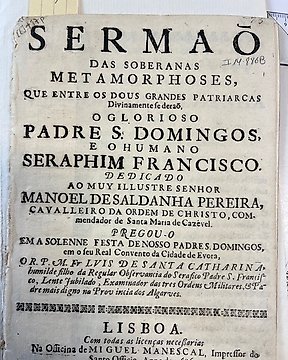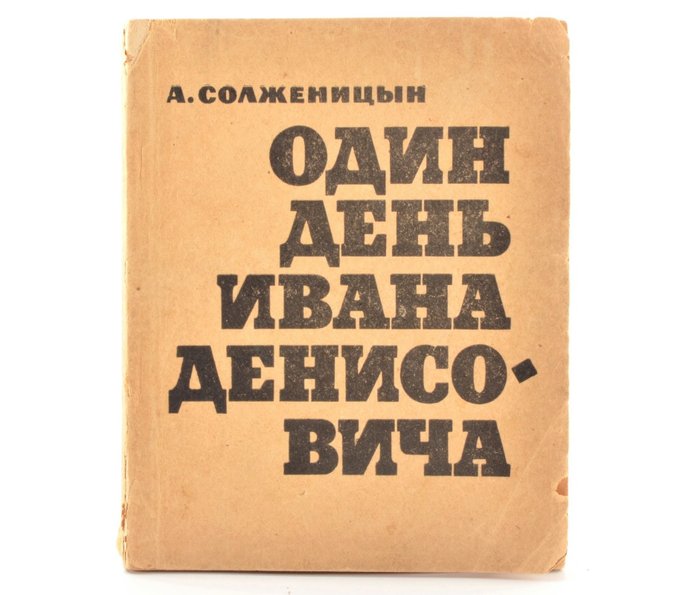
Luís de Santa Catarina - Sermão das Soberanas Metamorphoses que entre os dous grandes patriarcas - 1686
Nr 81843197

Nr 81843197

Solzhenitsyn, A.I. One day of Ivan Denisovich. The writer's first book
Soviet writer, 1963.
144 p. 16.5 x 12.5 cm.
In publisher's font cover.
The writer's first book.
“One Day in the Life of Ivan Denisovich” (original author’s title “Shch-854. One Day in a Prison”) is the first published work of Alexander Solzhenitsyn, which brought him worldwide fame. By the author’s definition, this is a story, but when published in the magazine “New World”, by decision of the editors, it was called a story “for weight.”
The story tells about one day in the life of a Soviet prisoner, Russian peasant and soldier Ivan Denisovich Shukhov: “It was just such a camp day, hard work, I was carrying a stretcher with my partner and I thought how to describe the whole camp world - in one day. Of course, you can describe your ten years of the camp, the entire history of the camps, but it’s enough to collect everything in one day, as if in pieces; it’s enough to describe only one day of one average, unremarkable person from morning to evening. And everything will be"
“One Day in the Life of Ivan Denisovich” was conceived in a camp in Ekibastuz in the winter of 1950-1951, and written in 1959 - started on May 18, completed on June 30 - in Ryazan, where Solzhenitsyn settled in 1957 upon returning from eternal exile. In 1961, a “lighter” version of the work was created, without some of the harsher judgments about the regime.
In December 1961, Tvardovsky gave the manuscript of “Ivan Denisovich” to Chukovsky, Marshak, Fedin, Paustovsky, and Ehrenburg to read. At the request of Tvardovsky, editor-in-chief of the New World magazine, they wrote their written reviews of the story. Tvardovsky planned to use them when promoting the manuscript in print. At that time, “Ivan Denisovich” had already begun to circulate in handwritten and typewritten copy lists. Members of the editorial board of "New World", as well as high-ranking figures of the CPSU, to whom the text was also presented for review, expressed a number of comments and complaints to the author of the work - they were dictated not by aesthetic, but by political considerations. The writer himself later wrote with irony about these demands: “And the funniest thing for me, a hater of Stalin, was that at least once it was required to name Stalin as the culprit of the disasters. (And indeed, he was never mentioned by anyone in the story! This is not accidental, of course, it happened to me: I saw the Soviet regime, and not Stalin alone.) I made this concession: I mentioned “the mustachioed old man” once...”
In July 1962, Tvardovsky, feeling that the censorship was preventing the story from being published in print for political reasons, wrote a short preface to the story and a letter addressed to the First Secretary of the CPSU Central Committee, Chairman of the Council of Ministers of the USSR Nikita Khrushchev with a brief assessment of the work. In September, during rest hours, Khrushchev began reading a story. He was excited and ordered that 23 copies of “Ivan Denisovich” be provided to the CPSU Central Committee for leading party figures. On September 15, Tvardovsky was informed that Khrushchev had approved the story. On October 12, 1962, under pressure from Khrushchev, the Presidium of the CPSU Central Committee decided to publish the story, and on October 20, Khrushchev announced this decision of the Presidium to Tvardovsky.
On November 18, 1962, the edition of the magazine “New World” No. 11 with “One Day in the Day of Ivan in the Day of Ivan Denisovich” was printed and began to be distributed throughout the country. Initially, the magazine's circulation was 96,900 copies, but with the permission of the party, an additional 25,000 copies were printed.
In the summer of 1963, “One Day in the Life of Ivan Denisovich” was published as a separate book by the publishing house “Soviet Writer” with a circulation of 100,000 copies). The news of the publication of the story spread throughout the world. Solzhenitsyn became an instant celebrity. On December 30, 1962, Solzhenitsyn was admitted to the Union of Writers of the USSR. On December 28, 1963, the editors of the magazine “New World” and the Central State Archive of Literature and Art nominated “One Day in the Life of Ivan Denisovich” for the Lenin Prize in Literature for 1964. The nomination of a literary work of “small form” for such a high prize was perceived by many “literary generals” as at least blasphemous; this had never happened in the USSR.
Okhlopkov S.167.
Jak kupować w serwisie Catawiki
1. Odkryj coś wyjątkowego
2. Złóż najwyższą ofertę
3. Dokonaj bezpiecznej płatności